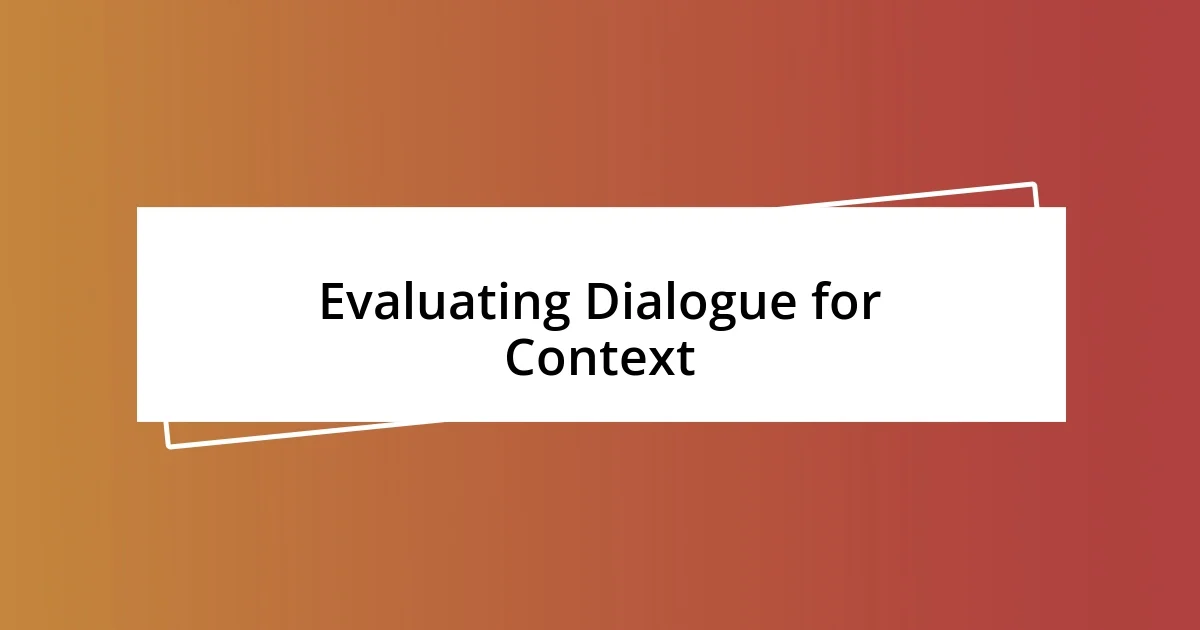Key takeaways:
- Dialogue is essential for revealing character depth, setting the emotional tone, and connecting readers to the narrative.
- Key elements of effective dialogue include character voice, context, and subtext, which shape the underlying meaning of conversations.
- Analyzing character intentions and non-verbal cues enhances the richness of dialogue, adding complexity and inviting deeper reader engagement.

Understanding the Importance of Dialogue
Dialogue serves as the heartbeat of storytelling, providing a dynamic pulse that drives the narrative forward. I remember reading a novel where the characters’ conversations revealed their deepest fears and hopes, making me empathize with them on a profound level. Have you ever experienced that moment when a character’s dialogue resonates so deeply that it lingers in your mind long after you’ve turned the last page?
Beyond mere exchanges of words, dialogue is crucial for revealing character development. In my own writing, I often experiment with how a subtle change in tone can shift the entire meaning of a conversation. For instance, I once crafted a scene where a seemingly casual chat between friends unveiled secrets that transformed their relationship. Isn’t it fascinating how a few carefully chosen words can expose the layers of a character’s personality?
Moreover, dialogue can create a vivid sense of place and time, anchoring readers in the world of the story. I’ve found that when characters interact in their unique ways, it paints a clearer picture of their environment and era. Think about it: has a character’s dialogue ever transported you to a different setting, making you feel like you were part of their realities? It’s this power of connection that makes dialogue an indispensable tool in storytelling.

Identifying Key Dialogue Elements
Identifying key dialogue elements is essential for crafting meaningful conversations in storytelling. I often focus on three primary aspects: character voice, context, and subtext. Each element plays a vital role in conveying the nuances of a conversation. For example, I once wrote a scene where two characters spoke about the weather, but their underlying tension revealed their unspoken conflict. It was a reminder that what isn’t said can often speak louder than the words themselves.
- Character Voice: Each character should have a distinct way of speaking that reflects their background, personality, and emotional state.
- Context: The situation surrounding the dialogue can greatly influence its meaning. I remember a scene where a character’s choice of words shifted dramatically when they were alone compared to when they were with a group.
- Subtext: This involves the underlying messages or emotions that aren’t explicitly stated. I’ve found that crafting dialogue with subtext adds layers and depth, inviting readers to read between the lines.

Analyzing Character Intentions
Analyzing character intentions can offer profound insights into the narrative and drive readers to deeper engagement. I recall a scene I wrote where two characters seemed to agree on a plan, but their body language suggested mistrust. This contrast between what was seen and what was felt created a tension that intrigued readers. When I dissected their dialogue, I realized the choice of words disguised their true motivations, revealing layers of fear and desire lurking just beneath the surface.
When I reflect on character intentions, I often think about how dialogue can unearth a character’s goals. For instance, in one story, a character’s seemingly innocent question about another’s absence carried a heavy load of jealousy. This subtlety made me appreciate how crucial it is to analyze what lies behind each line. Sometimes, I ask myself: “What do they really want?” This question can be illuminating, guiding my approach to writing and editing.
Ultimately, recognizing intentions in dialogue allows me to understand characters more deeply. I once revised a chapter where a character reacted defensively during a conversation. What seemed like anger at first morphed into a realization of vulnerability. I’ve learned that when I peel back the layers of conversation, I not only enhance the character’s depth but also create a richer, more relatable narrative.
| Intentions | Examples |
|---|---|
| Surface Intention | Underlying Message |
| Agreement | Underlying mistrust |
| Innocent inquiry | Jealousy |
| Defensive reaction | Vulnerability |

Exploring Subtext in Conversations
Recognizing subtext in conversations adds complexity to my storytelling. I remember writing a dinner scene where two friends exchanged compliments, yet their eyes darted around the table, betraying an undercurrent of competition. It made me realize that sometimes the most poignant feelings lie in what’s unspoken. Was it jealousy, or perhaps unresolved issues? These questions resonated with me and pushed me to layer my dialogue with hidden meanings.
I like to think of subtext as the invisible thread connecting characters’ words to their true feelings. One time, I crafted a conversation between a mother and daughter where they discussed a seemingly mundane topic—what to cook for dinner. However, beneath the surface, their choice of meal reflected the daughter’s desire for approval and the mother’s struggle with letting go. That’s when I understood that a simple dinner choice could mirror deeper relational dynamics. It made me ask myself: Are my characters’ words just a façade hiding their true selves?
Exploring subtext not only enriches dialogue but invites readers to dig deeper. I once had a character say, “Do you really think we’ll be okay?” in a casual tone, but the trembling of their hands revealed their vulnerability. In this moment, I learned that the dissonance between spoken words and non-verbal cues could portray a spectrum of emotions. That made me think: How can I use subtext to bridge the gap between what characters say and what they truly feel? Taking this approach expands the narrative and keeps readers engaged in the emotional journey of the characters.

Evaluating Dialogue for Context
Evaluating dialogue for context is essential for understanding the dynamics at play in any narrative. I remember poring over a scene where two characters were discussing a mundane task, like cleaning out the garage. However, the context—unspoken resentment from past conflicts—transformed this simple chit-chat into a power struggle that revealed much about their relationship. It’s fascinating how a setting can influence what’s said and what remains unsaid, prompting me to always consider the emotional landscape when writing dialogue.
In my experience, context isn’t just about the situation in which characters find themselves; it’s also about their history and external pressures. I recall crafting a scene with a father and daughter who were arguing. Their exchange was filled with sharp words, but understanding their backstory—the mother’s departure—added profound layers to their disagreement. When evaluating dialogue, I find myself asking: “What histories are echoing in these words?” This question helps me to weave in nuance and gravitas that can resonate with the reader.
Moreover, I’ve learned that non-verbal clues can amplify the contextual reading of dialogue. During one writing workshop, a fellow writer shared a scene where a character awkwardly looked away while addressing their partner. That small gesture spoke volumes about his inner turmoil and insecurities. It made me realize the potency of combining dialogue with body language, and I started to appreciate how context not only defines the words chosen but also the emotions conveyed. How often do we overlook these details that breathe life into our characters and their interactions?

Techniques for Effective Dissection
Dissecting dialogue effectively requires a keen eye for detail. I once worked on a scene where two colleagues were discussing a project. On the surface, it felt like a standard workplace interaction, but digging deeper, I realized that their body language told a different story. One character leaned back, arms crossed, while the other leaned in, eager to impress. This contrast revealed an unspoken struggle for dominance, which added an unexpected layer to their dialogue. Have you ever noticed how much can be said without a single word being spoken?
Another powerful technique is to play with pacing. I recall a tense conversation between two friends who were confronting a betrayal. By deliberately inserting long pauses after heated accusations, I could create an atmosphere of discomfort that echoed their emotional turmoil. Each pause heightened the tension, illustrating that the weight of words can be felt in the silences as well. I often ask myself, how do moments of hesitation shift a conversation’s tone?
Finally, the use of irony can enrich dialogue, making it more thought-provoking. I wrote a scene where a character cheerfully stated, “I just love being stuck here with you!” while their tone dripped with sarcasm. This juxtaposition not only entertained but also captured their true feelings about the situation. I find it fascinating how irony can turn a simple conversation into a commentary on relationships. How often do we mask our feelings with humor, and what does that say about our connections with others?

Applying Insights to Your Writing
Taking the insights gained from dialogue dissection into my own writing has transformed how I craft interactions. For instance, I once wrote a scene where a couple was deciding on dinner. While it seemed light-hearted, I reflected on their recent history of financial struggles. Suddenly, their debate about pizza versus sushi became a nuanced discussion of choices available and deeper emotional stakes. Have you ever pondered how seemingly trivial decisions can reveal larger issues at play?
I also found that incorporating layers of subtext can really elevate dialogue. In a short story, I had a character offer compliments to another, but by channeling their insecurities through more covert gestures—like a twitch at a compliment or a lack of eye contact—I highlighted a façade of confidence that didn’t reflect their true feelings. This added a complexity that resonated. It made me wonder: how often do our words mask what we really think or feel?
Finally, I believe that asking questions within dialogues can invite readers to engage more actively. In a recent piece, I included a character who, instead of making definitive statements, often posed questions like, “Are we really happy here?” This not only propelled the conversation forward but also echoed the uncertainties of modern relationships. I realized that dialogue isn’t just about exchanging information; it’s a vibrant dance of inquiry and reflection. Have you ever experienced moments where questions opened up entirely new avenues of discussion?














